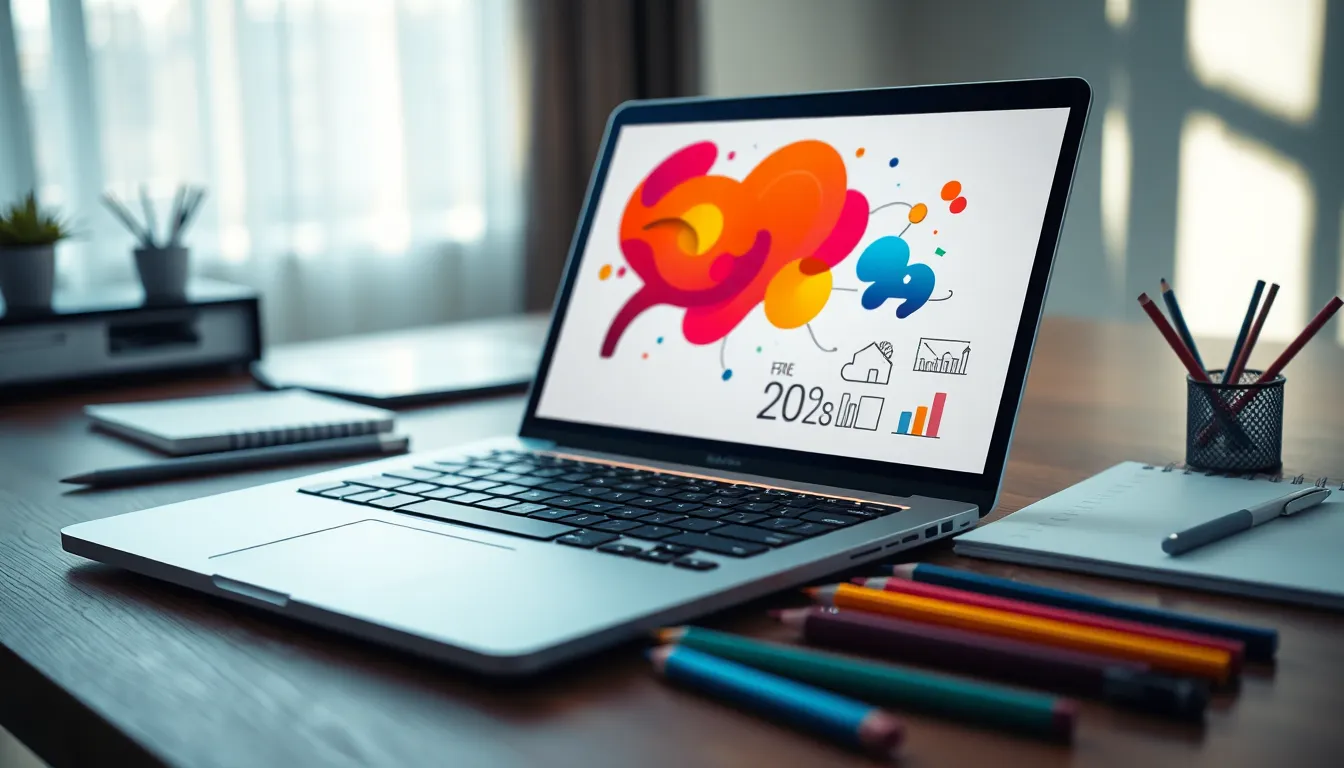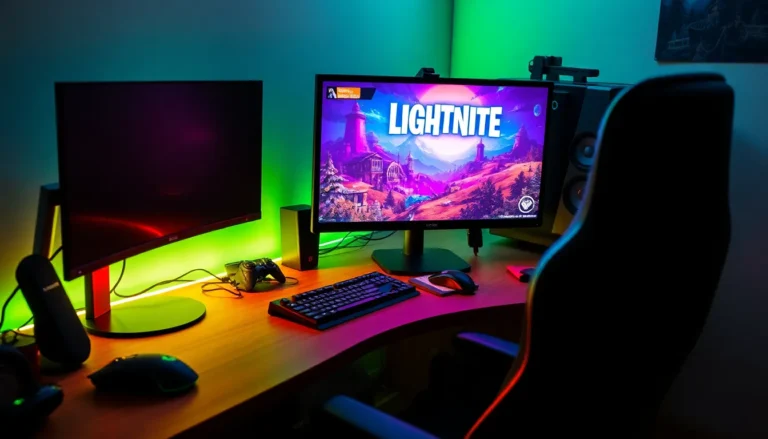Table of Contents
ToggleIn the world of graphic design, having the right laptop is like having a trusty sidekick—essential for unleashing creativity and tackling projects with flair. Whether it’s crafting stunning visuals or editing high-resolution images, the right machine can make all the difference. But with so many options out there, finding the perfect laptop can feel like searching for a needle in a haystack, or worse, a stylus in a messy desk drawer.
Importance Of A Good Laptop For Graphic Design
A good laptop serves as a foundation for successful graphic design. Performance impacts everything from rendering graphics to running design software smoothly. Professionals rely on high-resolution displays for accurate color reproduction, essential for visual elements.
Storage plays a critical role in handling large files and applications. Designers benefit from laptops with SSDs due to faster load times and improved performance. Processing power becomes vital for multitasking between software like Adobe Photoshop and Illustrator.
Portability matters for graphic designers who often work on the go. A lightweight, versatile laptop enhances convenience when meeting clients or attending events. Battery life supports extended use without frequent recharging disruptions.
Connectivity also holds significance in graphic design. Multiple USB ports enable easy connection to peripherals such as graphics tablets and external drives. Wi-Fi capabilities should provide fast, reliable internet access for cloud storage and collaborating with remote teams.
Investing in a suitable laptop improves workflow efficiency and creativity. A well-chosen machine minimizes frustration from lag or insufficient power. Designers achieve their vision while maximizing productivity when equipped with the right tools.
Key Features To Look For

When selecting a laptop for graphic design, key features significantly impact performance and usability. Understanding these aspects can streamline decision making.
Display Quality
Display quality stands paramount for graphic design. High-resolution screens provide accurate color representation and fine detail. Designers should prioritize laptops with at least a Full HD resolution, though 4K displays offer even greater clarity. Look for IPS panels, as they provide wider viewing angles and better color accuracy. Color gamut support, ideally covering 100% sRGB or Adobe RGB, enhances visual fidelity.
Processing Power
Processing power crucially influences design workflow. A laptop with a multi-core processor enhances the ability to run demanding software smoothly. Select a machine equipped with at least an Intel i5 or AMD Ryzen 5 processor for decent performance. Higher-end options, like Intel i7 or Ryzen 7, significantly boost efficiency for heavy multitasking. Speed often matters, so consider clock speed alongside core count to achieve an optimal balance in performance.
RAM and Storage
RAM and storage directly impact multitasking and file management. A minimum of 16GB RAM is recommended for seamless operation of graphic design applications. Ample RAM allows for fluid switching between software and prevents slowdowns during intense sessions. Storage options also matter; SSDs provide faster load times than traditional hard drives. Aim for at least 512GB SSD storage, which accommodates large files and applications while enhancing overall performance.
Graphics Card
The graphics card plays a vital role in rendering and manipulating visual content. Integrated graphics may suffice for basic tasks, yet a dedicated GPU offers significant advantages. NVIDIA’s RTX series or AMD’s Radeon Pro line cater to professional-grade graphic design. Look for a minimum of 4GB VRAM to ensure smooth operation in graphics-intensive applications. A robust graphics card facilitates faster rendering and enhances the overall design experience.
Top Recommendations
Selecting the right laptop for graphic design is pivotal. Here are some top choices that stand out in performance, display quality, and overall functionality.
Laptop 1: MacBook Pro 16-Inch
The MacBook Pro 16-Inch features a Retina display with True Tone technology, delivering vibrant colors and impressive clarity. Powered by the Apple M1 Pro or M1 Max chip, it excels in processing tasks that cater to design software. Coupled with a minimum of 16GB RAM and 512GB SSD, it handles high-resolution files effortlessly. Portability isn’t sacrificed, as this model balances power and weight. Designers benefit from its impressive battery life, which supports long editing sessions without frequent charging.
Laptop 2: Dell XPS 15
Dell’s XPS 15 offers a stunning 4K OLED display that enhances color accuracy for graphic design projects. Equipped with an Intel i7 processor and NVIDIA GeForce GTX 1650 Ti, it provides superior graphics rendering capabilities. It can be configured with up to 32GB RAM and 1TB SSD, ensuring ample storage for large projects. Compact design makes it easy to transport, catering to on-the-go designers. Reliable battery performance allows uninterrupted work sessions, making it a solid choice for creatives.
Laptop 3: ASUS ROG Zephyrus G14
The ASUS ROG Zephyrus G14 stands out for its AMD Ryzen 9 processor and NVIDIA GeForce RTX 3060 graphics. Boasting a 14-inch QHD display, it offers exceptional color fidelity and detail, crucial for design work. With options for up to 32GB RAM and 1TB SSD, it manages intensive tasks seamlessly. Lightweight and portable, this laptop fits comfortably into any bag, catering to designers seeking flexibility. Battery longevity supports extended use, proving advantageous for creatives on the move.
Budget-Friendly Options
Choosing a laptop for graphic design on a budget doesn’t mean compromising on quality. Several options provide excellent performance without breaking the bank.
Laptop 4: Acer Aspire 5
Acer Aspire 5 delivers solid performance for graphic design at an attractive price point. This laptop features a 15.6-inch full HD display, which ensures clear visuals and accurate color representation. Equipped with an AMD Ryzen 5 processor and 8GB of RAM, it efficiently handles design tasks and multitasking. The inclusion of a 512GB SSD enhances load times and manages large files effortlessly. Additionally, the laptop’s lightweight design promotes portability, making it suitable for designers on the move.
Laptop 5: Lenovo IdeaPad 3
Lenovo IdeaPad 3 stands out as another budget-friendly choice for graphic designers. This model comes with a 14-inch full HD display, offering vibrant colors and sharp details. An AMD Ryzen 5 processor, paired with 8GB of RAM, provides adequate power for running multiple design applications simultaneously. The 256GB SSD allows for quick access to files and applications, though an upgrade may be necessary for extensive storage needs. Weighing under 4 pounds, this laptop emphasizes convenience without sacrificing performance quality, appealing to creatives needing flexibility.
Choosing the right laptop for graphic design can significantly impact a designer’s workflow and creativity. With the right features like a high-resolution display powerful processing capabilities and ample storage designers can work efficiently and effectively. The options highlighted in this article cater to various needs from high-end models for professionals to budget-friendly choices for those starting out.
Investing in a suitable laptop not only enhances productivity but also ensures that designers can fully realize their creative visions. As technology continues to evolve staying informed about the best laptops available will empower designers to make choices that best suit their unique requirements.





